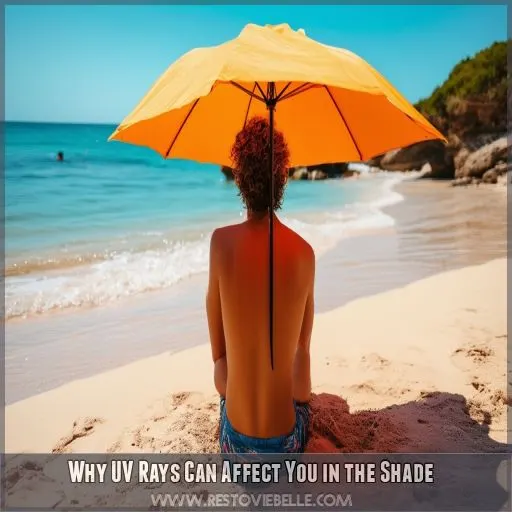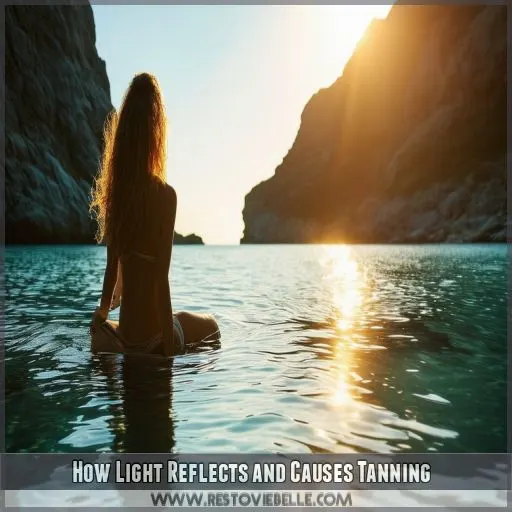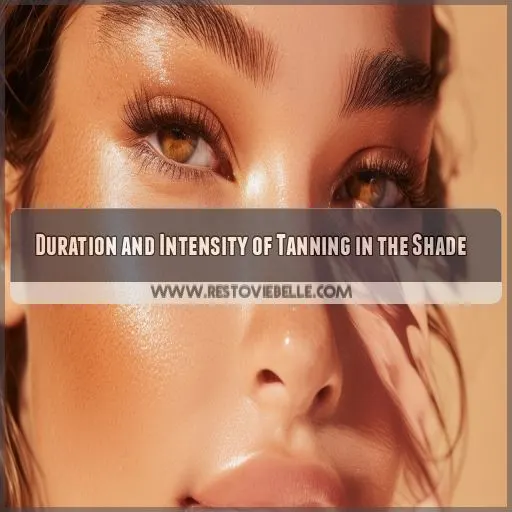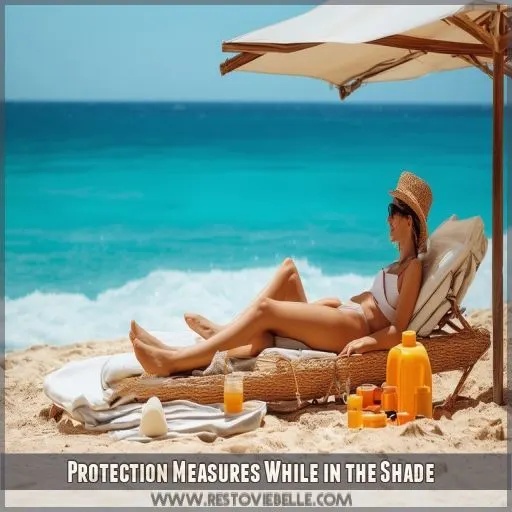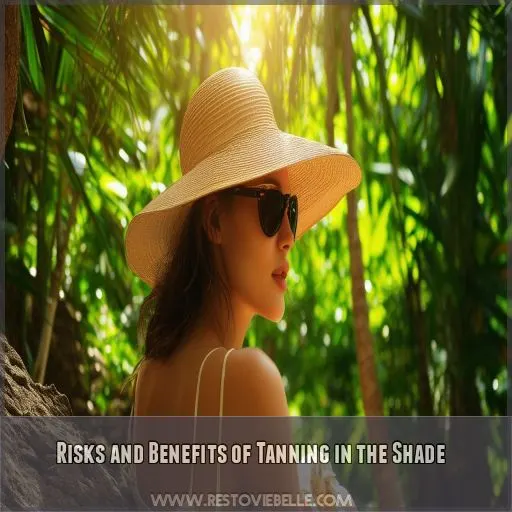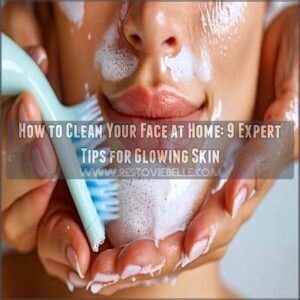This site is supported by our readers. We may earn a commission, at no cost to you, if you purchase through links.
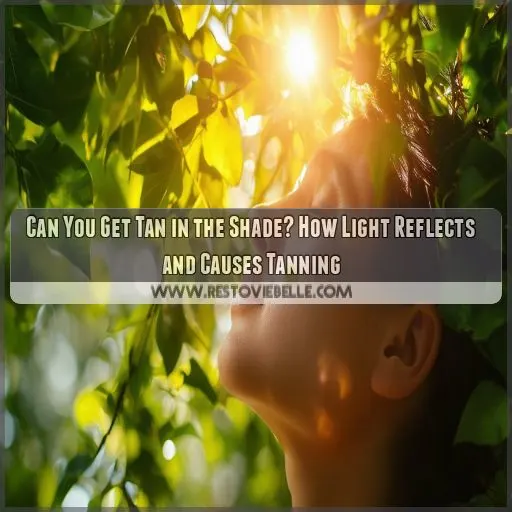 Whether you’re seeking a sun-kissed glow or simply curious about the science of tanning, you may have wondered: Can you get a tan in the shade?
Whether you’re seeking a sun-kissed glow or simply curious about the science of tanning, you may have wondered: Can you get a tan in the shade?
It’s time to explore the intriguing interplay of light and skin.
Table Of Contents
Key Takeaways
Even in the shade, UV rays can reflect off surfaces like sand, water, or buildings, and reach your skin, resulting in a tan. UVA rays penetrate deep into the skin, darkening melanin, while UVB rays can still impact you, potentially causing burns. Tanning in shaded areas may produce a less intense and shorter-lasting tan compared to direct sun exposure due to lower UV intensity. It’s important to remember that while tanning in the shade can stimulate melanin production, it’s not a safe alternative to direct sunlight, and it still poses risks of skin damage and cancer.
Can You Get Tan in the Shade?
Yes, you can still get a tan while in the shade. UV rays can reflect off surfaces like concrete and water, reaching your skin even when you’re not in direct sunlight. UVA rays, in particular, can penetrate deep into your skin, causing melanin production and skin darkening.
The duration and intensity of tanning in the shade depend on various factors, including the time of day, cloud cover, and the reflectiveness of surfaces around you.
To find out more about how you can still get a tan while in the shade, and how to protect yourself, continue reading.
Why UV Rays Can Affect You in the Shade
Even when you’re in the shade, UV rays can still affect you. Reflected UV radiation bounces off light-coloured surfaces and can reach your skin. Surfaces like concrete, light-coloured paint, and metallic surfaces reflect more UV radiation than darker surfaces. Sand reflects up to 25% of UV radiation, so if you’re under a beach umbrella, you’re still exposed to UV rays.
Additionally, the amount of open sky you can see from under a shade structure affects your exposure to indirect UV rays. Solid roof structures with wide overhangs and limited sky view offer better protection. Trees with broad canopies and dense foliage provide good coverage from direct overhead UV rays at midday but are less effective at blocking diffuse rays in the morning and afternoon.
Cloud cover also plays a role. Clouds scatter UV rays, making them more diffuse. And don’t forget, even when you’re in the shade, it’s important to wear protective clothing and sunscreen to shield your skin from UV rays.
How Light Reflects and Causes Tanning
Yes, you can get a tan in the shade because UV rays can reflect off surfaces like water, sand, and buildings. UVA rays penetrate the skin, causing melanin to darken, while UVB rays can still reach you, leading to potential burns.
UVA Rays Penetrate Skin
UVA rays are a sneaky bunch. They can penetrate deep into your skin, causing a rapid darkening of melanin and even redistributing it. But here’s the kicker: this skin darkening from UVA exposure doesn’t actually increase your melanin production or offer much protection against sunburn. So, while you might think you’re getting a nice, even tan, you’re mostly just getting a dose of UVA radiation.
- UVA rays cause oxidative stress, which oxidizes existing melanin and leads to rapid skin darkening.
- UVA rays may also redistribute melanin, but the total quantity remains unchanged.
- Skin darkening from UVA exposure doesn’t increase melanin production or provide significant sunburn protection.
- UVB rays, on the other hand, trigger increased melanin production as a protective response to direct DNA damage.
Melanin Darkens Skin
Your skin’s response to UVA rays is to produce more melanin, which is responsible for that tanned look. Melanin is a pigment produced by specialized cells called melanocytes and acts as your body’s natural sunscreen, protecting your skin from UV damage. The more melanin your body produces, the darker your skin becomes. This process is a protective mechanism, as melanin absorbs UV radiation, preventing it from damaging your skin cells.
| Type | Description |
|---|---|
| Melanin | A pigment that gives colour to your skin, hair, and eyes. |
| Melanocytes | Specialized cells that produce melanin. |
| UVA Rays | Penetrate deep into the skin and cause melanocytes to produce more melanin. |
| UVB Rays | Primarily cause sunburns and are less responsible for tanning. |
| Skin Tanning | The process of your skin darkening due to increased melanin production, triggered by UVA ray exposure. |
UVB Rays Burn Skin
UVB rays are a major cause for concern regarding skin damage. With higher energy levels than UVA rays, they directly damage DNA in the outermost layers of your skin. This can lead to:
- Sunburns
- Blistering
- Skin cancers, including melanoma
- Premature skin ageing
To prevent UVB-related skin damage, it’s essential to take sun protection measures, such as seeking shade, wearing protective clothing, and using UV-blocking products.
Duration and Intensity of Tanning in the Shade
The duration and intensity of tanning in the shade depend on various factors, including the time of day, cloud cover, reflective surfaces, clothing type, and skin tone. Even in the shade, UV radiation can reach your skin, and the type of shade matters. For example, an umbrella provides less protection than an indoor space, as UV rays can penetrate materials differently. UVA rays, which increase melanin and signs of ageing, can even pass through windows.
| Factor | Description | Impact |
|---|---|---|
| Time of Day | UV rays are more intense during spring and summer | Higher tanning potential |
| Cloud Cover | Clouds reflect UV radiation | Increased exposure |
| Reflective Surfaces | Surfaces reflect UV rays | Increased exposure |
| Clothing Type | Clothing provides varying levels of protection | Lighter clothing offers less protection |
Protection Measures While in the Shade
While spending time in the shade can reduce your direct exposure to the sun’s rays, it doesn’t eliminate the risk of UV radiation entirely. Here are some precautions to take to further protect yourself:
- Apply sunscreen: Choose a broad-spectrum sunscreen with an SPF of at least 30, and don’t forget to reapply it every two hours or after swimming or sweating.
- Wear protective clothing: Opt for lightweight, tightly woven fabrics that block UV rays. Don’t forget to cover your head with a wide-brimmed hat and protect your eyes with UV-blocking sunglasses.
- Detect UV radiation: Use a UV radiation detector or a UV index app to check the intensity of UV radiation in your area. This can help you time your outdoor activities to avoid peak hours.
- Limit your tanning duration: Even in the shade, prolonged exposure to the sun can increase your risk of UV damage. Set a timer to remind yourself to seek complete shade or move indoors, especially during the middle of the day when the sun is at its strongest.
Risks and Benefits of Tanning in the Shade
While tanning in the shade can stimulate melanin production, the reduced UV exposure may limit the intensity and duration of the tan. Carefully considering the risks and benefits of shade tanning, such as skin safety, can help you make informed decisions about your sun exposure.
Melanin Production
Melanin is a natural pigment produced by melanocytes, the cells in the basal layer of your skin. When exposed to UV light, your body produces more melanin to protect your skin cells from damage. This increase in melanin production is what creates a tan. However, tanning is an indication that cellular damage has already occurred.
The extra melanin in tanned skin only provides an SPF of 2-4, far below the recommended SPF of 15. So, while melanin offers some protection against UV rays, it’s not enough to prevent sun damage or skin cancer.
UV Exposure
While spending time in the shade can reduce your direct UV exposure, it doesn’t eliminate it entirely. UV rays, especially UVA rays, can scatter and bend, reaching you even in shaded areas. This indirect UV exposure can still cause tanning and increase your risk of skin damage over time.
The melanin in your skin, produced as a protective response to UV exposure, acts as a natural sunscreen, absorbing and scattering UV rays to prevent them from penetrating deeper into your skin. However, this protective mechanism has its limits, and prolonged UV exposure, even in the shade, can lead to skin damage and increase your risk of skin cancer.
Skin Safety
While tanning in the shade, it’s essential to remember that it’s not a safe alternative to direct sunlight. Even in the shade, UV rays can reach your skin, and the risks of skin damage and cancer are still present. Here are some key points worth noting:
- Sunlight Sensitivity: Even on cloudy days, UV rays can penetrate and cause sunburn. Sand, snow, and water reflect rays, increasing the chances of sunburn even in the shade.
- Skin Cancer Risks: Tanning, whether in the sun or shade, damages DNA in your skin. This increases the risk of skin cancers like basal cell carcinoma, squamous cell carcinoma, and melanoma.
- Tanning Lotion Effectiveness: Consider using sunless tanning products to achieve a tan without exposing yourself to harmful UV rays.
Frequently Asked Questions (FAQs)
What are the different types of UV rays?
There are three main types of UV rays: UVA, UVB, and UVC. UVA has the longest wavelengths, followed by UVB, and UVC, which has the shortest. All types of UV radiation can damage your skin and increase your risk of skin cancer.
Does tanning oil help you tan faster?
Tanning oil helps you tan faster by attracting more UV rays, intensifying melanin production. Tanning oils work best when you already have a base tan.
Are there any natural sunscreen alternatives?
The sun is a powerful force, and you need armor to shield yourself.
Natural sunscreen alternatives offer protection. Some options include aloe, coconut oil, and raspberry seed oil, which provide varying levels of SPF.
Zinc oxide and wheat germ seed oil create a physical barrier against UVA and UVB rays.
Protective clothing is another natural way to avoid sun exposure. Long sleeves and wide-brim hats are recommended.
How does indoor tanning work?
Indoor tanning uses devices that emit ultraviolet radiation, including tanning booths, beds, and lamps. These devices produce UV-A and UV-B rays, which are less harmful than the UV-C rays emitted by the sun.
What are the long-term effects of tanning?
The long-term effects of tanning include premature aging, which may manifest as wrinkles, dark spots, and a leathery texture. More seriously, tanning increases your risk of developing skin cancer, including melanoma.
Conclusion
So, can you get a tan in the shade?
Absolutely. Even without direct sun exposure, reflected UV rays can cause tanning and sunburn.
This fact highlights the importance of taking precautions, such as seeking shade and applying sunscreen, to protect your skin from the cumulative impact of UV rays.
Understanding the interaction between light and skin empowers you to make informed decisions about sun exposure, whether you’re aiming for a golden tan or just spending time outside.

